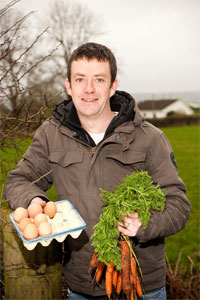Grow It Yourself - February
 Though we haven’t quite reached ‘hungry gap’ territory yet, I think it’s fair to say at this stage that we are beginning to pass the point of plenty as far as last year’s harvest is concerned. We still have plenty to eat in the veg patch and in stores, but things are a little scarce and some vegetables are starting to run out altogether.
Though we haven’t quite reached ‘hungry gap’ territory yet, I think it’s fair to say at this stage that we are beginning to pass the point of plenty as far as last year’s harvest is concerned. We still have plenty to eat in the veg patch and in stores, but things are a little scarce and some vegetables are starting to run out altogether.
Last month we ate the last of our onions, and though we still have a braid of shallots in the kitchen, we’ve been buying nets of onions which is annoying. We are in the death throes of our 2013 carrot crop and I am simultaneously pleased to have made it this far and annoyed that I didn’t grow more.
Being the quintessential stock pot and soup ingredient, carrots are one of those vegetables that you really can’t do without, unlike say butternut squash which one could happily forego for a couple of months.
I am going to do an early sowing in the polytunnel but it will be months before they are ready, so for now, reluctantly, I am back to buying them and the perennial hunt for a good source of organic carrots continues.
There are however, other active sources of food. In the kitchen I still have plenty of garlic, squashes, pumpkins, chilli-peppers, and the aforementioned shallots. I’d be lost without the pickle/chutney shelf, particularly when it comes to the school lunches – a simple slice of ham can be turned in to serious sandwich with a good dollop of some chutney or other. The freezer still turns up an occasional nugget of wonderfulness – tonight for example, it was some beautiful broad beans.
In the polytunnel, we’ve still plenty of winter greens. In the veg patch I still have a decent number of parsnips in the ground. I haven’t counted them, but if I had to guess I’d say there are maybe 20-25 of them still.
Close by, there’s a great crop of leeks – surely another 4-6 weeks worth. We used the first of them over Christmas and they truly are wonderful - though they are not classed as a ‘green’, they taste fresh and spring-like.
Finally, there’s also still plenty of life in my kale and perpetual spinach plants and I noticed the other day that the rhubarb plants are showing signs of life again too. So, all in all, there are reasons to be cheerful!
To Do
Turn over the soil only if the weather is dry – if the soil sticks to your boots it’s too early for digging! Keep off the soil to prevent soil compaction - use timber planks to stand on for access. If you have not already done so order/buy your seeds, spuds and onion sets.
“Chit” or sprout seed potatoes – put them in a container (e.g. used egg carton or empty seed tray) and leave them in a bright warm place. Check the pH of your soil – you can buy a soil pH testing kit in any garden centre. Lime your soil now if required (to reduce acidity in very acid soils), particularly important in your brassica bed.
Sow
Finally, we can sow some seeds. On a sunny windowsill indoors, in a heated greenhouse or on a heating mat: sow celery, globe artichokes, celeriac, leeks, onions, lettuce, tomatoes, peas, aubergines, peppers/chilli-peppers. In polytunnel or greenhouse: beetroot, Brussels sprouts, summer and autumn cabbage, carrots, leeks, lettuce, radish.
Outside: Weather permitting you can try planting out broadbeans, spinach, kohlrabi, onion and shallot sets, Jerusalem artichokes, parsnip and early pea varieties.
Harvest
Winter cabbage and cauliflowers, Brussels sprouts, spinach, kale and leeks.
Recipe of the Month – Mick’s Minestrone Soup
This is a completely made up recipe that I cobbled together this week using some vegetables that I brought in from the garden and some standard store cupboard ingredients. So, honestly, I don’t know if Minestrone is the right word for it – but it seems to fit.
The added pasta makes it a substantial feed, and because it’s not blitzed in a blender after cooking, it’s chunky and delicious. You can play around with different vegetables if you don’t have what I added here.
Serves 4.
Ingredients:
• 2 tablespoons olive oil
• 1 onion, chopped
• 1 clove garlic, chopped
• 1 leek, cleaned and finely sliced
• 2 carrots, peeled and chopped small
• Half a butternut squash or small pumpkin, peeled and chopped small
• 500ml good quality homemade chicken stock (or made from an organic stock cube)
• 400ml tin chopped tomatoes (I used the same quantity of passata instead).
• 4 tagliatelle ‘nests’, preferably organic (you could use any type of pasta really).
• 1 bunch spinach leaves, stalks removed and chopped roughly
Directions:
Heat the oil in a large pot and cook the onions and garlic until softened. Add the leek, carrot and squash and toss well so they are coated in oil.
Season well, then cover and cook on a low heat with the lid on the pot, stirring occasionally, for 5-10 minutes.
Then add the stock and tomato and cook with the lid off until the veg is soft (about 10 minutes) – don’t overcook, you don’t want the veg to go to mush.
Stir in the spinach about 5 minutes before the end of cooking.
Meanwhile cook the pasta as per instructions in a pot of boiling, salted water. When it’s cooked, drain and stir it in to the soup pot. Check the seasoning.
Ladle in to warm bowls and serve with some crusty bread.
Tip of the Month – Show your tools some love
Blades on shears, forks, spades, hoes, secateurs and other tools will benefit from an annual overhaul with a sharpening stone (you can buy them in hardware stores).
Prepare the blade with a drop of three-in-one oil. Push the tool forwards and to the side on the stone, exerting a little downward pressure. Then turn the tool over and, holding the blade almost flat against the stone, brush it across the surface to take off any rough edges. Only sharpen the outside blade on bypass secateurs and the upper surface of hoes. Wipe over the blade with an oily rag before storing.
 About GIY
About GIY
GIY is a not-for-profit organisation that aims to create a healthier, more sustainable world where people grow their own food. We inspire and support people to grow food more successfully by bringing them together to share advice, tips and ideas. There are approximately 50,000 people involved in the GIY movement in Ireland, which is proudly supported by Woodies DIY. For more information check out www.giyireland.com.
For more information check out www.giyireland.com
Michael Kelly is a freelance journalist, author and founder of GIY Ireland.
© GIY Ireland 2014 – all rights reserved.






There are currently no comments
Leave a comment
Not a member? Register for your free membership now!
Or leave a comment by logging in with: